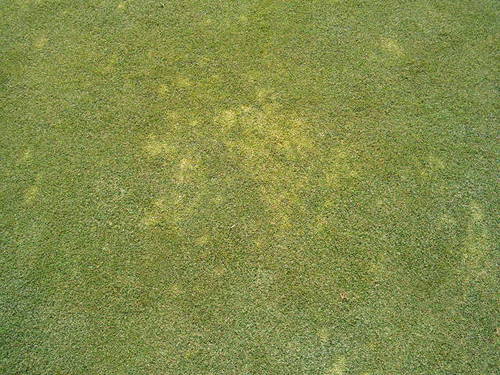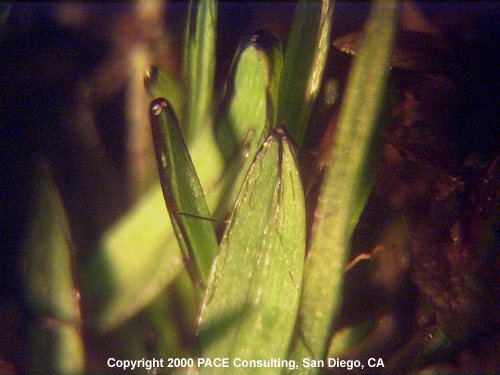Dollar spot, brown ring patch, rapid blight and fairy ring seem to be pretty active in the state and southern blight is starting to show up in parts of northern and central CA.

With the lack of the usual California sunshine, we are also starting to get a lot of algae samples coming into the diagnostic lab. Under cloudy conditions, Oscillatoria spp. of algae often develop on greens when the soil surface is wet for an extended period of time and often high thatch and organic matter make the problem worse. Algae can seal the soil surface reducing plant growth and some species of algae can produce a toxin that causes turf yellowing.


(photos used by permission, www.paceturf.org)
Improving surface drainage and increasing light exposure will help reduce the impact of algae as will certain fungicide applications. Chlorothalonil (Daconil), mancozeb (Fore) and hydrogen dioxide (ZeroTol) were shown to be very effective in reducing algae in UCR trials. Applications should be made 7 to 14 days apart to reduce the algae. However, if the surface moisture remains high, algae can often recolonize areas.
GCSA of Southern California Scholarship & Research Tournament
This last Monday, I had the pleasure to help out at GCSASC's S&R Tournament at Industry Hills Golf Course as many of our local superintendents played golf to raise money for southern California schools. Greg Fukumitsu (Syngenta Professional Products) drove his industrial-strength BBQ rig down from Ventura Co. to grill tri-tip and sausages for the players along side Dean Mosdell (Syngenta) and Mike Sommer (Simplot Partners). I have no idea what Greg's secret recipe is, but his tri-tip was as addicting as crack cocaine.
GCSASC also awarded three scholarships to some of our local students including Jerry Hernandez (College of the Desert), Brent Barnes (UC Riverside) and Marvin Seamus (Cal Poly Pomona).
I was very happy to have spent most of the day dishing out tri-tip, getting ice and driving VIPs like Jim "Speedy" Lipari and association manager Cyndy Neal around the course instead of looking at plugs of moldy turf. Thanks again to GCSASC for supporting research and education in California!


















2 Responses to “Algae and Tri-Tip”
Frank,
My father went to the Santa Maria barbeque where they first did the tri-tip for years. He first purchased the seasoning then made his own. We received this as a present for many years. Somewhere in the house we have a copy of the recipe when he tried to write it down (often it was a little of this and that). I will try to find you the recipe.
Leah A. Brilman
Long Beach Lawn Bowling Club, California is using a mix of 50% household bleach, 50% water, and a tablespoon of liquid dishwashing detergent/2 gallons to control algae and moss on a difficult North Green. This was recommended in Haley's manual.
December 2014 has been a moist yet warm season. Two applications one week apart. Dramatic change. IT also appears to discourage Poa and Perl-wort. Our greens are a "tiff 2 Bermuda hybrid."
Post a Comment